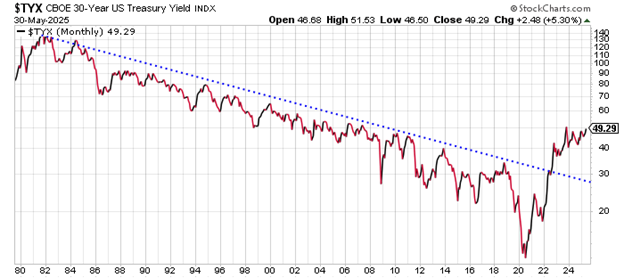If you’re looking for financial advice, seek out someone with wrinkles and gray hair.
Most folks under 50 years old have no idea what’s coming next. They’ve never experienced a rising interest rate environment.
Look at this chart of 30-year interest rates…

Long-term interest rates peaked in 1982, with the 30-year Treasury Bond yielding 14%.
Rates then declined for the next 40 years – hitting as low as 0.4% during the COVID crisis in 2020.
But, look at what has happened in the last three years. The 30-year Treasury yield broke out above a 40-year declining resistance line.
Interest Rates Are in a Bull Market
Interest rates entered a new, long term bull market – meaning Treasury Bonds entered a bear market. Rates are 60% higher today than they were in 2022.
They’re 1,100% higher than they were at the bottom in 2020.
In other words, the cost of borrowing money is 11 times greater today than it was five years ago.
Most folks, most companies, and most governments manage their debt by taking out new loans to pay off older debt as it matures. And, for the past 40 years we’ve been able to do this at perpetually lower interest rates. This allowed us to borrow even more money without incurring larger debt payments.
People could buy bigger homes. Companies could pay premium prices to buy out competitors or buy back their own shares. Governments could spend money recklessly without feeling the pinch of fiscal budget restraints.
There were no consequences to borrowing money. Deficits didn’t matter.
Now though, with long-term interest rates recently hitting the highest level in 20 years, it costs more to borrow money. Any maturing debt must be refinanced at higher rates.
Nobody is refinancing their mortgage anymore and taking out a pile of cash to spend on their lavish lifestyles. Companies can’t borrow cheap money to buy back expensive shares.
You’ll Have to Know How to Play the Consequences
And the U.S. government – with $9 trillion of its $36 trillion national debt due to mature in 2025 – for lack of a better word… is screwed. All of that debt will be refinanced at higher interest rates.
Some of us wrinkled, gray-haired, old folks remember what it was like living in the 1970s. We’ve seen how financial assets perform in a rising interest rate environment.
And, we’ve frequently been mocked for pointing to the ever-growing, massive mountains of consumer, corporate, and government debt and suggesting caution.
“Deficits don’t matter,” the younger folks shout at us. “The national debt has grown from less than $1 trillion in 1982 to almost $37 trillion today, and nothing bad has happened.”
They ask, “What’s different this time?”
Take another look at the chart above. This time, you’ll see the difference.
Best regards and good trading,

Jeff Clark
Editor, Market Minute
P.S. In markets like this… buy and hold investors get absolutely hosed. My style of investing does best in uncertain, chaotic, and volatile markets.
And… my strategies also make money during crashes. It’s true, I had one of my best trading years ever in 2008… but we don’t have to look that far back to see the results of my strategies.
We just have to look back to the April “Liberation Day” downturn. Since that downturn, across my services we’ve had 18 winners: three triple-digit winners and fourteen double-digit winners. In less than two months.
You can check out one of the strategies I use right here.
Free Trading Resources
Have you checked out Jeff’s free trading resources on his website? It contains a selection of special reports, training videos, and a full trading glossary to help kickstart your trading career – at zero cost to you. Just click here to check it out.
